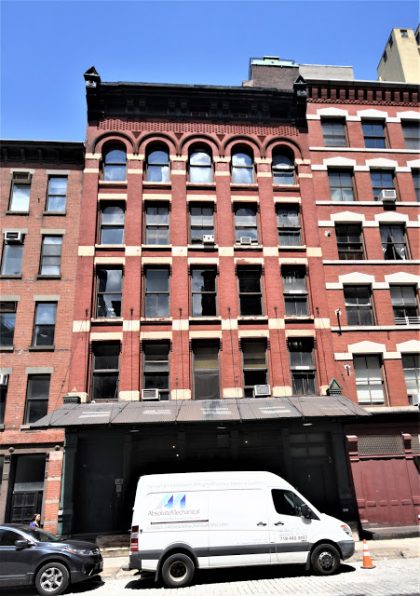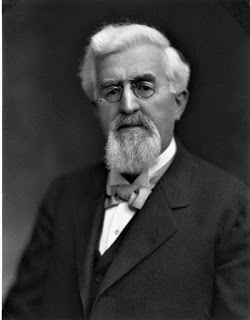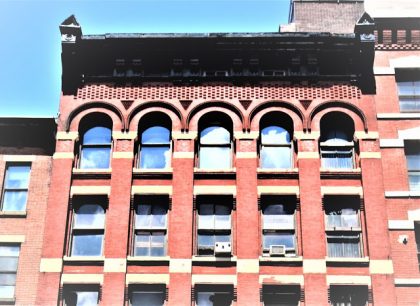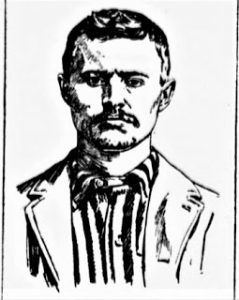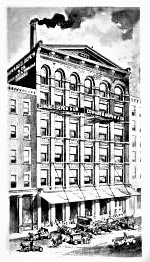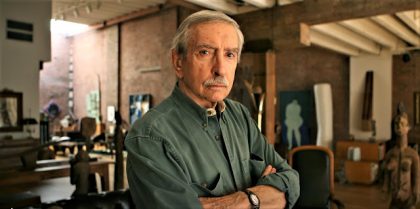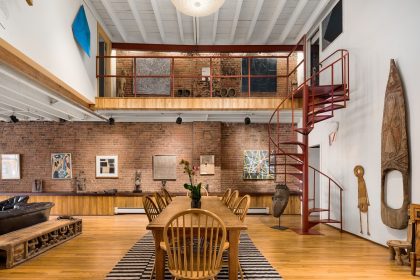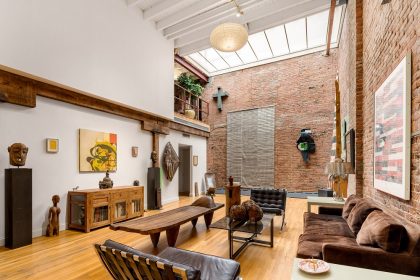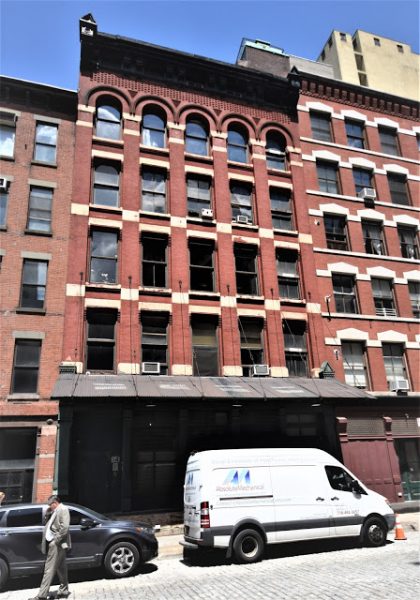The History of 14-16 Harrison Street – The Henry Heide Building
 Tom Miller, who writes about the history of Manhattan buildings at Daytonian in Manhattan, has allowed Tribeca Citizen to create a database of his Tribeca posts. If you enjoy these, and you will, then you should definitely check out his website, which also has write-ups about buildings all over the island. And don’t miss his book, Seeking New York: The Stories Behind the Historic Architecture of Manhattan—One Building at a Time.
Tom Miller, who writes about the history of Manhattan buildings at Daytonian in Manhattan, has allowed Tribeca Citizen to create a database of his Tribeca posts. If you enjoy these, and you will, then you should definitely check out his website, which also has write-ups about buildings all over the island. And don’t miss his book, Seeking New York: The Stories Behind the Historic Architecture of Manhattan—One Building at a Time.
··································
Born in Germany in 1846, Henry Heide immigrated to America at the age of 20, just after the end of the Civil War. After briefly running a grocery store he found his true calling–making candy. In 1868 he founded the Henry Heide Candy Company. The firm obtained a patent in 1875 for a “new and improved preserve composition for macaroons.” Heide’s almond paste would be touted as “the finest article ever invented for macaroons [sic] and general baking purposes” by Illustrated New York in 1888.
On April 29, 1881 Heide purchased the two wooden houses at Nos. 14 and 16 Harrison Street from Aymar Embury. He paid $15,500 for the properties–about $380,000 today. Six months later, on October 29, the Real Estate Record & Builders’ Guide reported that architect George Da Cunha “is at work on plans for a stone building to be built in Harrison street, between Hudson and Greenwich streets, for Henry Heide. It will be of brick with stone trimmings, 40×100, and will cost $30,000.” The total cost of the project now amounted to what today would equal about $1.15 million.
Completed the following year, Da Cunha’s candy factory was a handsome blend of neo-Grec and Queen Anne styles. The first floor, above a raised loading dock, was faced in cast iron. Here architectural details, like the pyramidal caps of the end piers, mimicked those of the upper cornice. The windows of the second through fourth floors wore neo-Grec lintels supported on stepped brick corbels. At the fifth floor the arched openings sat below projecting brick eyebrows. The Queen Anne style stepped in with triangular, dog-tooth spandral panels below a honeycomb frieze formed by recessed bricks. Above the cast metal cornice was a triangular pediment.
The firm’s success and growth prompted Heide to lease No. 18 Harrison Street in the spring of 1886. Architect Thomas R. Jackson was hired to connect the buildings internally.
Two years later Illustrated New York described the combined premises as “divided into manufacturing and sales departments, equipped with every modern appliance for rapid and successful production and perfect in convenience of arrangement for inspection and sale.” By now, said the writer, Henry Heide Candy was “One of the most prominent and best known houses in this line of industry in New York.”
The firm’s astounding growth was evidenced in the comment “Mr. Heide has a new building in course of erection, which will connect the rear of this building through to Franklin Street, and which will be six stories high.” When completed, the candy factory was an unlikely pasting together of three separate buildings. And then in 1891 Heide added yet another property, the adjoining Nos. 181-183 Franklin Street. The four joined buildings comprised about 50,000 square feet.
At the time Heide’s bookkeeper was a young German man, Otto Kuhn. In the days when many transactions were conducted in cash, his was a highly responsible position. In February 1891 he approached Heide and asked “if he could be spared for a few months to take a flying trip to Europe,” according to The Evening World. (The term “flying trip” referred to its short length and had nothing to do with the yet-to-be-invented airplane.)
The 27-year-old married man may have initially intended to skip town to avoid prosecution. The Evening World reported that not long after his departure Heide “discovered that money was missing, and an investigation of Kuhn’s books, it is alleged, revealed a shortage of about $1,000.” It was a significant amount, equal to about $28,500 today.
If Kuhn had intended to remain in Europe, he changed his mind. Detectives learned that he was aboard the White Star steamship the Britannic headed to New York and on April 10 were at the dock to meet it. “Kuhn admitted that he had stolen the $1,000,” reported The Evening World, “and squandered it in gambling houses and high living.”
More serious troubles came in the form of another German-born employee, candy packer Charles Miller. After the night watchman, August Loeffler reported that the 25-year-old Miller was a loafer, he was fired “for neglect of duty.” Enraged, Miller was bent on revenge.
On the afternoon of April 18, 1894 he sneaked into the factory and hid in the cellar. Miller silently waited until the employees had gone home and night fell. About 1:00 a.m. he attacked.
The following morning, according to The Sun, “the body of the night watchman was found in the basement of the factory. His skull was crushed in, and several ribs were broken.” The cash drawer had been emptied of $17.
Miller may have gotten away with the murder had he not remained in the vicinity. The Sun said “he was seen hanging about the neighborhood of the factory. Some one noticed blood on his clothes, and remembered that he had been discharged on account of the watchman’s report three weeks before.” He was arrested on suspicion and confessed at Police Headquarters.
Police released a chilling description of the crime. “Miller lay in wait for his victim and hit him on the head with a heavy hammer. Then maddened by the sigh of blood, he had jumped on the body, breaking the ribs.”
The story of Charles Miller ended in even more violence and tragedy. After occupying cell 67 in The Tombs prison four months, he was found by a jail keeper on the morning of August 9 with his throat slashed by a razor. Miller was still alive and taken unconscious to Bellevue Hospital. Surgeons valiantly attempted to save his live, but he died there within a few hours. How he obtained the razor to commit his gory suicide was never discovered.
Almost unbelievably, the Henry Heide Candy Co. had again outgrown its immense factory building. Now, in 1895, Heide obtained the real estate at the corner of Hudson and Vandam Street and began construction of a cutting-edge structure. When completed the factory had a daily capacity of 250,000 pounds of confectionery products. (As an interesting side note, in the first half of the 20th century the Henry Heide company would introduce the gummy candies Jujyfruits and Jujubes, a staple for movie goers for decades.)
Henry Heide retained ownership of the four buildings on Harrison and Franklin streets, and after the candy company moved out they were separated. Nos. 14-16 was leased to Edward D. Depew & Co., wholesale grocers.
The residency of Edward D. Depew & Co. was relatively short-lived. On December 30, 1908 the New York Produce Review and American Creamery reported “The Harrison Street Cold Storage Company has secured a twelve years lease on the six story and basement brick buildings at 14 and 16 Harrison street.” The article said the structure “will be entirely refitted for modern cold storage…The new plant will be insulated with cork board from the Armstrong Cork Company of Pittsburg.” The Harrison Street block was developing into what would be called the “butter and egg district” and the journal commented that the building would be “carrying butter and eggs.”
Henry Heide hired architect Nelson K. Vanderbeck to upgrade the building for his tenant in the spring of 1911. Vanderbeck’s plans called for “cast-iron columns in 6-sty refrigerating warehouse.”
Five years later, in July 1916, Heide liquidated all of his Franklin Street and Harrison Street properties, selling them to the Red Diamond Realty Corporation. The new landlords leased the building to the Merchants Refrigerating Co.
In 1918 to The New York Butter Packing Co. rented space from that firm. The New York Produce Review and American Creamery explained that The New York Butter Packing Co. would “receive, store and deliver butter and eggs” from the address. It was a depot of sorts for the firm, its large packing and shipping plant being located at Newcomerstown, Ohio.
Two years later the New York Butter Packing Co. merged with C. F. Bullard’s Cudahy Packing Co. to form C. F. Bullard & Co. The American Produce Review reported that its offices would be at No. 171 Duane Street, and it would use the Harrison Street building as its warehouse. “The new concern will handle butter, cheese and eggs.”
As mid-century approached the J. S. Hoffman Company, cheese merchants, leased the building. On May 7, 1945 The New York Sun reported that the firm had purchased the building, along with the two structures at Nos. 179 through 183 Franklin Street. And once again the structures were internally connected. The deal amounted to $1.75 million in today’s dollars.
By the last quarter of the 20th century artists were displacing cheese, egg and butter dealers in the block’s vintage loft buildings. The former Henry Heide Candy factory was converted to “joint living/work quarters for artists.” There was one residence per floor through fourth story, with a duplex above. It may have been around this time that the pediment was removed.
The duplex became home to a celebrated occupant. In 1977 playwright Edward Albee purchased the space, filling it with modern art masterpieces by the likes of Chagall and Kandinsky, as well as a collection of African art.
The long wooden dining room table, where Albee reportedly wrote portions of his plays, was the scene of script readings, and the vast open space saw rehearsals. Once a year Albee threw his anticipated Christmas party attended by stage and screen royalty like Marlene Deitrich, Kathleen Turner and Lauren Bacall. Albee’s summer estate was in Montauk, Long Island.
Edward Albee died on September 16, 2016, having won three Pulitzer Prizes for Drama and two Tony Awards for Best Play. Among his best-known works were The Zoo Story, The Sandbox, Who’s Afraid of Virginia Woolf?, and A Delicate Balance.
Albee’s 4,515 square foot duplex was recently placed on the market for $7.5 million. In the meantime, the former candy factory is little changed–other than the lost pediment–including the permanent awning over the loading dock.







